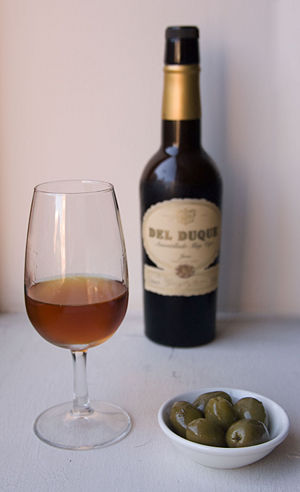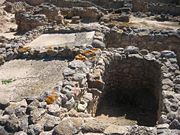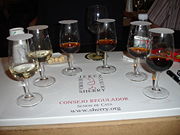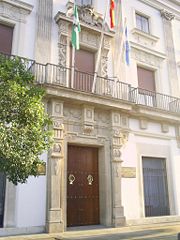Sherry

Sherry is a fortified wine made from white grapes that are grown near the town of Jerez, Spain. In Spanish, it is called Vino de Jerez. The word sherry is an Anglicization of Jerez. In earlier times, sherry was known as sack (from the Spanish saca, meaning “a removal from the solera”). According to Spanish law,[1] sherry must come from the small triangular area of the province of Cádiz between Jerez, Sanlúcar de Barrameda, and El Puerto de Santa María.
After fermentation is complete, sherry is fortified with brandy. Because the fortification takes place after fermentation, most sherries are initially dry, with any sweetness being added later. In contrast, port wine (for example) is fortified halfway through its fermentation, which stops the process so that not all of the sugar is turned into alcohol.
Sherry is produced in a variety of styles, ranging from dry, light versions such as Finos to much darker and sometimes sweeter versions known as Olorosos.
Contents |
History

Jerez has been a center of viniculture since wine-making was introduced to Spain by the Phoenicians in 1100 BC. The practice was carried on by the Romans when they took control of Iberia around 200 BC. The Moors conquered the region in 711 AD and introduced distillation, which led to the development of brandy and fortified wine.
During the Moorish period the town was called Sherish (a transliteration of the Arabic شريش), from which both Sherry and Jerez are derived. According to some people, however, the city of Shiraz in midsouthern Iran was the birthplace of "sherry" style wine.[2]
Though the drinking of alcohol is prohibited in the Qur'an, wine production continued through five centuries of Islamic rule. In 966 the Caliph of Cordoba Al-Hakam II ordered the destruction of the vineyards, but the inhabitants of Jerez appealed on the grounds that the vineyards also produced raisins to feed the empire's soldiers, and the Caliph spared two-thirds of the vineyards.
In 1264 Alfonso X of Castile took the city and it was renamed Xeres (over time the spelling was adjusted to Xerez, and finally Jerez). From this point on, the production of Sherry and its export throughout Europe increased significantly. By the end of the 16th century, Sherry had a reputation in Europe as the world's finest wine.
As a fortified wine, Sherry is better equipped than most table wines to survive sea transport. Christopher Columbus brought Sherry on his voyage to the New World and as Ferdinand Magellan prepared to sail around the world in 1519, he spent more on Sherry than on weapons.
Sherry wine became very popular in Great Britain, especially after Francis Drake sacked Cadiz in 1587. At that time Cadiz was one of the most important Spanish sea ports, and Spain was preparing an armada there to invade England. Among the spoils Drake brought back after destroying the fleet were 2,900 barrels of Sherry that had been on shore waiting to be loaded aboard Spanish ships.[3]
Because Sherry was a major wine export to the United Kingdom, many English companies and styles developed. Many of the Jerez cellars were founded by British families.
In 1894, the vineyards in the Jerez region were destroyed by phylloxera. Many vineyards replanted with resistant vines, but many smaller vineyards did not survive this infestation.
Styles

- Fino ('fine' in Spanish) is the driest and palest of the traditional varieties of Sherry.
- Manzanilla is a variety of fino Sherry made around the port of Sanlúcar de Barrameda.
- Amontillado is a variety of Sherry that has been aged first under a cap of flor yeast, and then is exposed to oxygen, which produces a result darker than fino but lighter than oloroso.
- Oloroso ('scented' in Spanish) is a variety of Sherry aged oxidatively for a longer time than a fino or amontillado, producing a darker and richer wine. With alcohol levels between 18-20%, olorosos are the most alcoholic Sherries in the bottle.[4]
- Palo Cortado is a rare variety of Sherry that is initially aged under flor like an amontillado, but develops a character similar to oloroso, with some of the richness of oloroso and some of the crispness of amontillado.
- Sweet Sherry (Jerez Dulce in Spanish) is created when one of the preceding varieties of dry Sherry is sweetened with Pedro Ximénez or Moscatel wine. Cream sherry is a common variety of sweet sherry made from oloroso, with other varieties including pale cream sherry (made from fino) and medium sherry (made from amontillado).
The "Sherry" brand

Spanish producers have registered the names Jerez / Xérès / Sherry and will prosecute producers of similar fortified wines from other places using the same name. In 1933, Article 34 of the Spanish Estatuto del Vino (Wine Law) established the boundaries of Sherry production as the first Spanish wine denominación. Today, Sherry's legal status is further recognized by wider EU legislation. Sherry must come from the triangular area of the province of Cádiz between Jerez, Sanlúcar de Barrameda, and El Puerto de Santa María. However the name 'Sherry' is used as a semi-generic in the United States where it must be labeled with a region of origin such as American Sherry or California Sherry.
Production
Climate
The Jerez district has a predictable climate, with approximately 70 days of rainfall and almost 300 days of sun per year. The rain mostly falls between the months of October and May, averaging 600 l/m². The summer is dry and hot, with temperatures as high as 40°C (104°F), but winds from the ocean bring moisture to the vineyards in the early morning and the clays in the soil retain water below the surface. The average temperature across the year is approximately 18°C (64°F).
Soil

There are three types of soil in the Jerez district for growing the grapes for sherry:[5]
- Albariza: the lightest soil, almost white, and best for growing Palomino grapes. It is approximately 40-50% chalk, the rest being a blend of limestone, clay and sand. Albariza preserves moisture well during the hot summer months.
- Barros: a dark brown soil, 10% chalk with a high clay content.
- Arenas: a yellowish soil, also 10% chalk but with a high sand content.
The albariza soil is the best for growing the Palomino grape, and by law 40% of the grapes making up a sherry must come from albariza soil. The barros and arenas soil are mostly used for Pedro Ximénez and Moscatel grapes.
The benefits of the albariza soil is that it can reflect sunlight back up to the vine, aiding it in photosynthesis. The nature of the soil is very absorbent and compact so that it can retain and maximize the use of the little rainfall that the Jerez region receives.[5]
Grapes
Before the phylloxera infestation in 1894 there were other varieties of grape used in Spain for the production of sherry, but now there are only three white grapes grown for sherry-making:
- Palomino: the dominant grape used for the dry sherries. Approximately 90% of the grapes grown for sherry are Palomino. As varietal table wine, the Palomino grape produces a wine of very bland and neutral characteristics. This neutrality is actually what makes Palomino an ideal grape because it is so easily enhanced by the Sherry winemaking style.[5]
- Pedro Ximénez: used to produce sweet wines. When harvested these grapes are typically dried in the sun for two days to concentrate their sugars.
- Moscatel: used similarly to Pedro Ximénez, but it is less common.
Sherry-style wines made in other countries often use other grape varieties.
Fermentation
The Palomino grapes are harvested in early September, and pressed lightly to extract the must. Only the must from the first pressing, the mosto de yema, is used to produce sherry; the product of additional pressings is used for lesser wines, distillation and vinegar. The must is then fermented in stainless steel vats until the end of November, producing a dry white wine with 11-12% alcohol content.
Fortification

Immediately after fermentation, the wine is sampled and the first classification is performed. The casks are marked with the following symbols according to the potential of the wine:
| / | a single stroke indicates a wine with the finest flavour and aroma, suitable for fino or amontillado. These wines are fortified to about 15% alcohol to allow the growth of flor. |
|---|---|
| /. | a single stroke with a dot indicates a heavier, more full-bodied wine. These wines are fortified to about 17.5% alcohol to prevent the growth of flor, and the wines are aged oxidatively to produce oloroso. |
| // | a double stroke indicates a wine which will be allowed to develop further before determining whether to use the wine for amontillado or oloroso. These wines are fortified to about 15% alcohol. |
| /// | a triple stroke indicates a wine that has developed poorly, and will be distilled. |
The sherry is fortified using destillado, made by distilling wine, usually from La Mancha. The distilled spirit is first mixed with mature sherry to make a 50/50 blend known as mitad y mitad, and then the mitad y mitad is mixed with the younger sherry to the proper proportions. This two-stage procedure is performed so the strong alcohol will not shock the young sherry and spoil it.
Aging

The fortified wine is stored in 600-litre casks that are made of North American oak, which is slightly more porous than French or Spanish oak. The casks, or butts, are filled five-sixths full, leaving "the space of two fists" empty at the top to allow flor to develop on top of the wine.
Sherry is then aged in the solera system where new wine is put into wine barrels at the beginning of a series of 3 to 9 barrels. Periodically, a portion of the wine in a barrel is moved into the next barrel down, using tools called the canoa (canoe) and rociador (sprinkler) to move the wine gently and avoid damaging the layer of flor in each barrel. At the end of the series only a portion of the final barrel is bottled and sold. Depending on the type of wine, the portion moved may be between 5 and 30 percent of each barrel. This process is called "running the scales," because each barrel in the series is called a scale.
So the age of the youngest wine going into the bottle is determined by the number of barrels in the series, and every bottle also contains some much older wine. Sherry is aged in the solera for a minimum of 3 years.
Storing and drinking

Once bottled, sherry does not benefit from further aging and may be consumed immediately, though the sherries that have been aged oxidatively may be stored for years without losing their flavor. Bottles should be stored upright to minimize the wine's exposed surface area. As with other wines, sherry should be stored in a cool, dark place.
Fino and Manzanilla are the most fragile types of Sherry, while amontillados, olorosos and cream sherry are able to last several weeks or even months after opening. Some versions sweetened with Pedro Ximénez can also last a while due to the sugar content acting as preservatives in the wine. In Spain, the more fragile sherry types are often sold as half bottles with any remaining wine being thrown out if it isn't drunk the same day it is opened.[6]
Sherry is traditionally drunk from a copita, a special sherry glass that is tulip shaped. Once opened, sherry will begin to lose its flavor and should be kept corked and refrigerated. Depending on the type, it may last from one week up to a few months after opening.
See also
- Brandy de Jerez
- Sherry Vinegar
- Cooking sherry
- Ratonero Bodeguero Andaluz
References
- ↑ Spanish law
- ↑ Maclean, Fitzroy. Eastern Approaches. (1949). Reprint: The Reprint Society Ltd., London, 1951, p. 215
- ↑ The Story of Wine by Hugh Johnson, p. 94. ISBN 1840009721.
- ↑ T. Stevenson "The Sotheby's Wine Encyclopedia" pg 325 Dorling Kindersley 2005 ISBN 0756613248
- ↑ 5.0 5.1 5.2 K. MacNeil The Wine Bible pg 438 Workman Publishing 2001 ISBN 1563054345
- ↑ K. MacNeil The Wine Bible pg 447 Workman Publishing 2001 ISBN 1563054345
External links
- Official sherry website
- Information about the town of Jerez de la Frontera in Andalucia, southern Spain
- Sherry Institute of Spain's promotional website for cooking with sherry
- Basic Juice's postings: "Very Simply Sherry I", "Very Simply Sherry II" and"Very Simply Sherry III"
- Sherry 101 an explanation of styles with audio vocabularly examples.
|
|||||||||||||||||